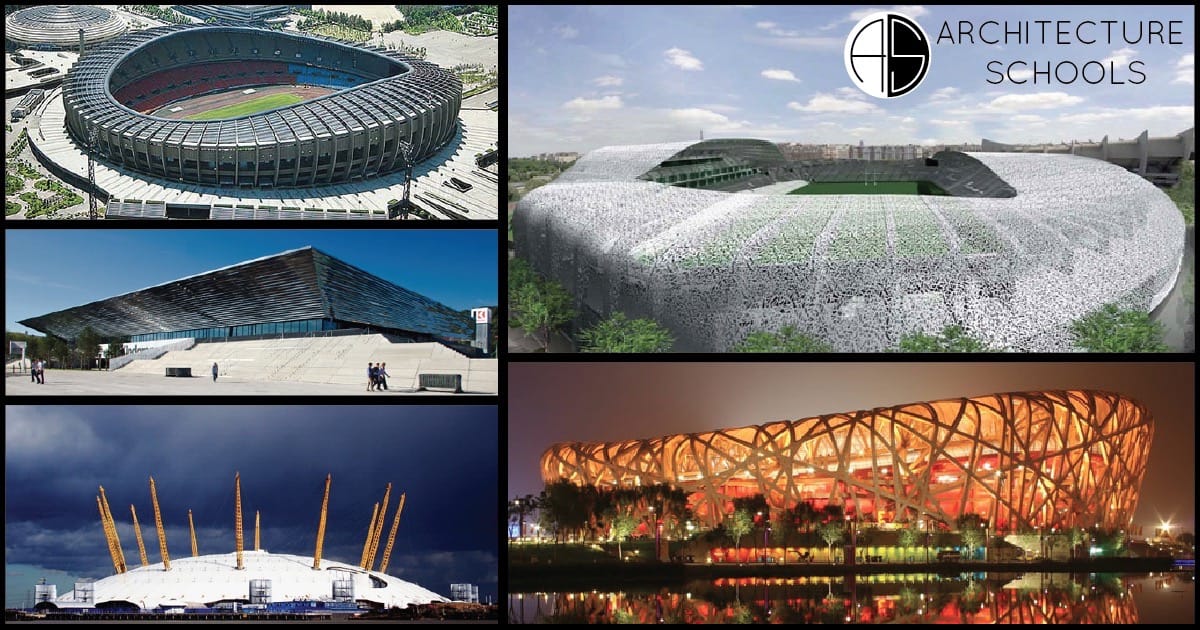Stadiums are as numerous and varied as sporting events. They are therefore a unique and complex job for architects.
Beijing National Stadium

Known as the “Bird’s Nest,” the Beijing National Stadium was built for the 2008 Summer Olympics. The architects Herzog & de Meuron and the Chinese artist Ai Weiwei were responsible for its design. The stadium is now used for national artistic and cultural events.
Allianz Arena

Located on the outskirts of Munich, Germany, the Allianz Arena was designed by the architectural firm of Herzog & de Meuron. Its unique facade, which earned it the nickname “rubber dinghy,” changes color depending on the team the stadium is hosting.
Jean-Bouin Stadium

Since its construction in 1925, the Jean-Bouin stadium in Paris has been renovated twice, first in 1970 by, then in 2013 according to the project of Rudy Ricciotti. The sports complex includes tennis, soccer and field field hockey courts, as well as an indoor gymnasium.
Palau Sant Jordi

Built for the Barcelona 1992 Olympic Games, designed by Japanese architect Arata Isozaki, the Palau Sant Jordi stadium is an example of modern architecture and engineering. Its structure is fully mechanized to adapt to all sports and temperatures.
Rouen Sports Palace

Also known as the Kindarena, the Palais des sports de Rouen is a design by French architect Dominique Perrault. Inaugurated in 2012, the multi-sports complex is among the most attended in all of France. Its capacity is up to 6,000 spectators, depending on the event.
Millennium Dome

The Millennium Dome, or O2 Arena, located in Greenwich (UK), was designed by Richard Rogers. The interior design is the work of Zaha Hadid. Its structure, composed of a large canvas supported by a number of pylons, makes it a temporary building that was only to be used for one year. However, since its inauguration in 2001, the Dome has been constantly renewed and has hosted various cultural and sporting events. It is the largest building of its kind ever built and has a capacity of 23,000 spectators.
Yoyogi National Gymnasium

Designed for the 1964 Summer Olympics in Tokyo, the Yoyogi National Gymnasium is an innovative building that has inspired many international architects. Its suspended roof was designed by Japanese architect Kenso Tange. During the 1964 Olympic Games, it hosted the swimming, diving and basketball events.
Suwon World Cup Stadium

Opened for the 2002 World Cup soccer tournament, the Suwon Stadium in South Korea is nicknamed “Big Bird”. It is the work of architect Aymeric Zublena, and the home of the Suwon Samsung Bluewings FC soccer team. The stadium, with its complex architecture, has a capacity of nearly 45,000 spectators.
Seoul Olympic Stadium

Designed by Korean architect Kim Swoo Geun, the stadium opened in 1984 after seven years of construction. With a capacity of nearly 70,000 spectators, Seoul Olympic Stadium has hosted major sporting and cultural events, including the 1988 Summer Olympics, as well as concerts by Michael Jackson and Lady Gaga.


